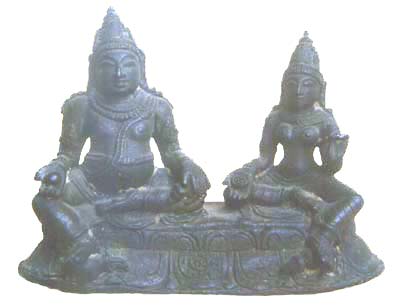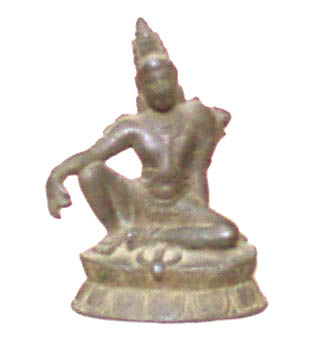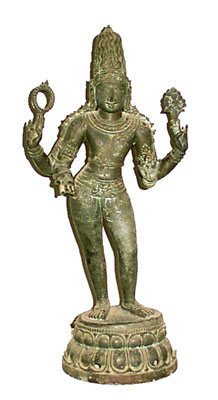 |

|
Jambhala and Vasudhara
Velippalayam,
Nagapattinam. Height with pedestal 9 cm; without pedestal 6.5 cm. About 10th
century AD. Acquired as a treasure trove in 1926 AD.
Jambhala
and Vasudhara are seated on an oval padmasana. A dharmachakra is
carved in front of the asana. Both have two stranded yajanopavita, and wear
no kundalas. Vasudhara's right hand holds a cup with dots meant for gems and
her left evidently held the ear of corn, which is broken and missing. Date Early Chola. |
| Lokesvara
Velippalayam,
Nagapattinam. Height with pedestal 7.7 cm; without pedestal 6.3 cm. About 9th
Century AD. Acquired as a treasure trove in 1926 AD.
He is seated in
the maharajalila pose on an oval padmasana. The right hand is extended, its
elbow resting on the right knee; left is resting on the seat and holding the stalk of a blue
lotus which can be seen resting against his left shoulder. The face is so worn out that the
features are not clear. Karandamakuta on head has pyramidal designs on it as in
Javanese makuta. patrakundala, necklaces, channavira, waist-girdle,
armlets, wristlets, padasaras, siraschakra and under-garment extending up to the knee
and with belt without simha mukha design on it are seen. Type resembles that of Java
and Nalanda.
Though Simhanada is generally represented in this pose, the
absence of his vahana, the lion would warrant its identification as Padmapani.
The type is Javanese and Nalanda.
|

|

|
Maitreya
Nanayakkara
Street, Nagapattinam. Height with pedestal 75 cm; without pedestal 62.5 cm. About
10th century AD. Acquired as a treasure trove in 1934 AD.
Maitreya is
standing in tribhanga on a circular padmasana having 4 holes for securing
the image to a base while carrying it in procession. The holes and the relatively big size of
the image prove that the image was one of the utsava-vigrahas. Four arms upper right
with rosary, upper left with a flower stalk from which spring 12 flowers and 2 buds (are
they nagapuspas), the lower right is in varada, the lower left in kataka
are seen. The hair is arranged flame-like resembling a jatamakuta with the design of stupa
infront; makara kundalas in the ears, necklaces, four stranded yajnopavita,
waist-girdle, loin-cloth with simha-mukha, armlets, wristlets, rings, padasaras
and sirascakra are seen. Comparable with Chola type; hence it is
indigeneous. The presence of a stupa on the makuta points to the identity of
the image as that of Maitreya.
|
|
 |
|